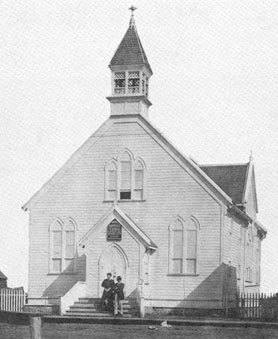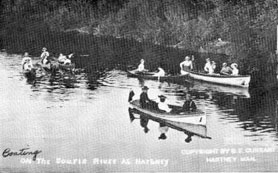|
THE
FIRST RECORDED MEETING of the founders of Hartney’s Anglican church was
in March 1894. Previously, Reverend William Albert Butterworth had held
services from 1892 in Bateman’s Hall, in a building owned by J.E.
Sparrow, and in the Orange Hall.
The first recorded baptism was that of Henry, son of W.E. Crawford at
Mr. Butterworth’s home in January 1893. Four other baptisms took place
in the Orange Hall in the same year. The first baptism in the church
was of Myrtle Ellen Shepherd on June 18, 1895. One of the first
marriages was that of Mr. and Mrs. Richard Moore of Elgin.
At a vestry meeting held August 11, 1894, it was decided that a church
should be built, the cost not to exceed $1500, of which $500 was to be
raised in cash. The cornerstone was brought from Boissevain, by team
and wagon, by Robert Taylor and Ben Roper, and the painting inside and
outside of the church was done by Robert Taylor. The chancel was added
some years later, around 1907. The cornerstone was laid by J. Ovas,
Grand Master of the Grand Lodge of Manitoba.
The rector’s stipend in 1896 was $250 per annum. Mr. Butterworth
remained in Hartney until 1897 and was rector in other parts of Canada
until 1907, when he returned to England. After his departure,
Canon Rogers of Winnipeg addressed a meeting of the vestry proposing
that St. Andrew’s by joined with St. Luke’s, Souris. This motion was
defeated and St. Andrew’s decided to carry on alone.
Rev. John Gibson was rector from 1899 until 1906. He also held
services in Elgin from 1900 until 1903 when a church was opened there.
Rev. D.J. Hull succeeded him in 1906.
Rev. G. Brownlee was rector from 1910 to 1912. Rev. C.A. Blay began his
ministry in Hartney on June 23, 1912, remaining for ten years, the
longest recorded time of office. From 1913 to 1918, he held services in
Lauder. In addition, he took services at Cavell and Findlay on
alternate Sundays, as well as morning and evening services at St.
Andrew’s.
At the annual meeting of April 1914, the ladies of the congregation
were for the first time, granted the right to vote on church affairs.
Early in 1915, at a vestry meeting, a motion was made by Robert Taylor,
seconded by James Barber, that the wardens be instructed to pay off the
church mortgage, and it was a very happy occasion for the congregation
and rector when on October 24, 1915, the church was consecrated by His
Grace, Archbishop Matheson of Rupert’s Land.
From A Century of Living, page 25.
While they were important leaders in a
community, the quick turnover of Anglican clergy noted above suggests a
rather less secure position than might be imagined. The clergy of
Hartney’s Baptist, Methodist and Presbyterian churches, were also
familiar with a similar transitory lifestyle.

Hartney’s handsome Baptist Church.
The Sporting Life
A tennis club was formed in 1893 with Rev. Butterworth of the Anglican
church as first president, Miss Nina Dickson was secretary and the
first treasurer was Miss Tena Hopkins who played tennis until 1930.
Three tennis courts were levelled and taped west of the railway tracks.
The ladies made the first nets and the men set them up. The tennis
courts became a social centre where young men and young ladies met
without benefit of chaperones. If warming to the game were a
prerequisite of successful playing, the costumes of the ladies must
have given them a distinct advantage. Pictures of the time show the men
in shirt sleeves and bowler hats while the women wore ground-length
full skirts, high-necked shirtwaists with long sleeves and sailor hats
held to high-piled hair by sturdy hatpins. Tennis was a dignified game
in those days.

Hartney’s tennis court is visible in the foreground
of this old photograph.
Lacrosse
Of all the sports enjoyed in the fist decades of Hartney, lacrosse was
the game that appealed most to players and spectators. In the first
year of the town’s existence there was a lacrosse team consisting of
business men, clerks and farmers. The team grew stronger until in 1898
it captured the championship of Western Canada at a game at Winnipeg
that aroused the Hartney folk to hilarious pitch. Edgar Russenholt was
a young boy, newly arrived in Hartney with his father and recalled the
home-coming of the victorious team:
Everyone in town and from miles around was at the station when the
train came in. The players put on quite a show. They wrapped bandages
around one another and came limping off the train on crutches and
canes. They piled onto high seats rigged up on one of Billy McDonald’s
big drays and were hauled in triumph through the streets by four sleek
horses with beribboned harness, and were preceded by the Hartney brass
band drawn on another dray. At the tail end of the procession came all
of us boys, hollering our lungs out.
Swimming and the Natatorial Society
Because Hartney had the advantage of being near the river, many happy
outings were connected with it. The boys early found it ideal for
swimming and the old swimming hole just west of the bridge was a
favourite summer meeting place. In the spring before mothers realized
that the river was clear, their sons came home with damp hair and often
with sniffles. Bathing suits were not always thought necessary and
warnings appeared from time to time against the indiscretion of the
boys who swam too close to the road for complete privacy, as well as
the suggestion that bathing suits were cheap.
For the girls who were barred by propriety from swimming at the river
the boys did, a swimming club gloried by the name “Natatorial Society”
was formed in 1914. Because no woman knew how to swim we had male
instructors for each of the three groups into which club was divided.
This made a chaperone for each club a necessity and they were duly
selected.
The would-be swimmers were dressed for propriety rather than for
swimming. Each wore a navy blue lustre blouse with elbow-length sleeves
and sailor collar, gathered knee-length lustre bloomers under decent
knee-length lustre skirts, and on their legs long black lisle
stockings. In order to teach us the proper strokes with touching us,
the instructor suspended his pupil face-downward by a strong band of
webbing much as if he were weighing her. Thus supported she struggled
to carry out his spoken instructions. Needless to say, few of us
learned to swim that summer.
Canoe
Club
One day in the spring of 1905 a few young men
gathered in Dr. Woodhull’s drugstore as they so often did. This time
they discussed boating and decided to form a canoe club. They ordered
three canoes through Hunter’s Hardware as a beginning. The Hartney
Manufacturing Company secured two more canoes which they sold to
prospective boatmen. The club and the canoes were launched. The new
owners took many other young men as crew members and that summer the
Souris was enlivened by their exploits. The following year a boathouse
was built, other canoes were purchased and canoeing became a popular
pastime with many participants and with an interested audience on the
bridge and river banks
Albert Henry and Dan Sutherland, not so young as the canoeists, each
bought gasoline launches in which they took young and old for rides
around the river’s curves. Walpole Murdoch was a frequent passenger and
noted the beauty of the green banks where gold finches, orioles and
swallows could be seen undisturbed and where even the beavers, growing
used to the boats, did not seem greatly disturbed.
Adapted from The Mere Living, page 160.

Hartney canoeists on the Souris River.
|





